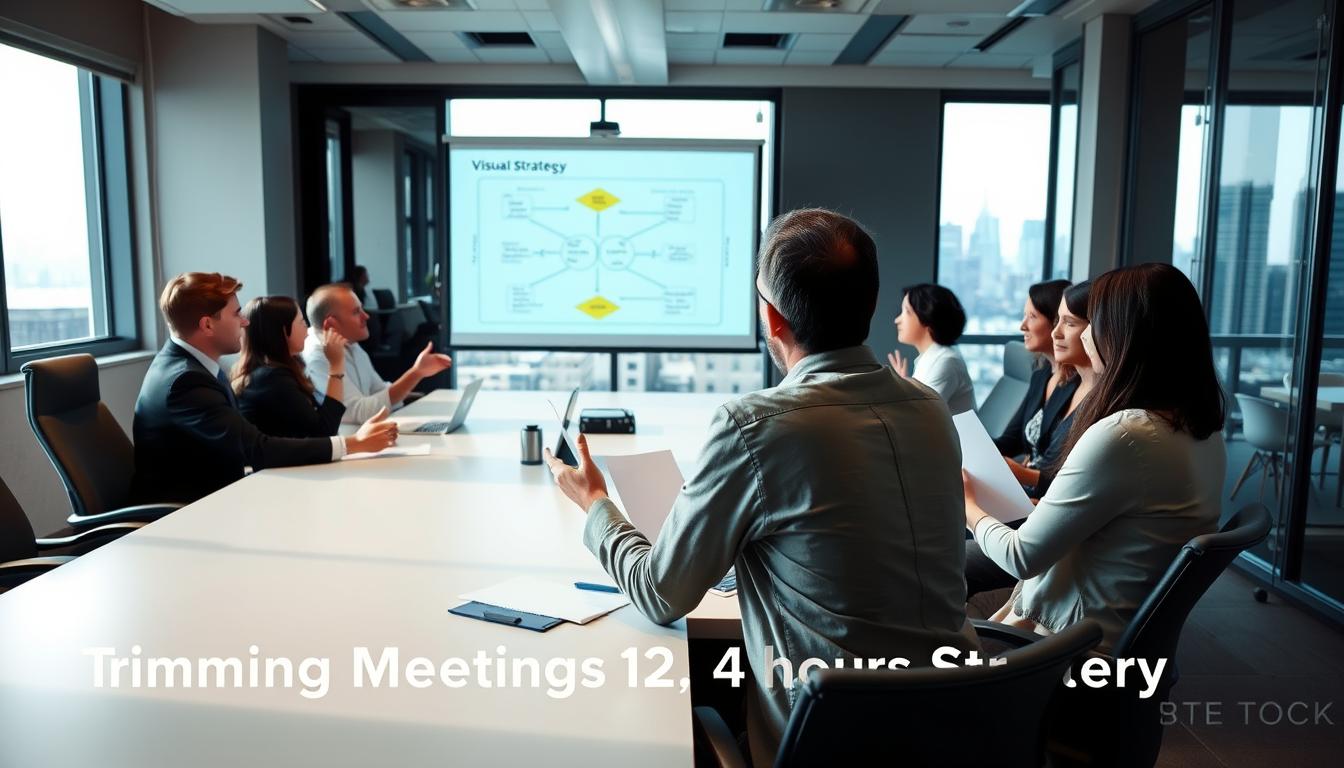In today’s fast-paced work environment, having effective team meetings is very important. Good meeting prep is key to increasing team engagement and productivity. This guide will help leaders and team members use strategies for better meetings.
By dealing with common meeting challenges and using tools that help teams work together, companies can use their time wisely. Let’s look at how impactful meetings can lead to team success.
The Importance of Effective Team Meetings
Team meetings are key for great communication and working together well. They’re not just for sharing info. They also help teams work on the same goals and solve problems better. In a good meeting, people bring up new ideas and help make big decisions.
If meetings aren’t done right, they can make team members unhappy. This can lower how much work gets done and hurt team spirit. Even though people often say meetings waste time, they’re really important. They help teams work together towards common goals.
Great meetings can really help teams work better and move forward. It shows why it’s important to have meetings that are well planned. Organizations that focus on good meetings are on their way to better teamwork and reaching their goals.
Understanding Common Meeting Challenges
Many organizations face issues with meetings that stop productivity and waste resources. When meetings aren’t useful, they frustrate team members and use up precious time. It’s important to fix these problems to make meetings better and more meaningful.
The Cost of Unproductive Meetings
Meetings that don’t produce results can be costly. A lot of our workweek goes into meetings. Studies show that up to 21% of work time is spent in them. Often, about a quarter of this time is just wasted, harming efficiency and morale.
Wasting time in meetings can also mean losing money. This is because time lost could have been spent on projects or with clients. When meetings are not managed well, it hurts the organization financially.
Survey Insights on Time Wasted in Meetings
Surveys show that wasting time in meetings is a big problem. Many people feel they’re unprepared or don’t know why the meeting is happening. This causes confusion and disorganization. These insights stress the importance of planning meetings carefully to avoid wasting time.
Key Strategies for Successful Meeting Preparation
Effective meetings are based on good structure and clear goals. A well-made meeting agenda is key. It outlines discussion topics and session goals. This helps everyone know what to expect and encourages participation and responsibility.
Creating a Clear Agenda
Think of a meeting agenda as a guide for a productive gathering. It focuses on important topics, making meetings more effective. A good agenda has:
- List of topics to be discussed
- Designated times for each agenda item
- Specific roles for participants
Following a detailed agenda helps teams avoid off-topic discussions and reach their goals.
Setting Objectives for Each Meeting
Having clear goals for each meeting enhances its purpose. It lets team members focus on important issues. Ensuring goals are clear means everyone can actively participate and keep track of progress. Keep these tips in mind:
- Ensure objectives are specific and measurable
- Communicate the expectations to all participants
- Review objectives at the beginning and end of the meeting
Using these tips for meeting prep helps improve their effectiveness and builds a responsible team culture.
How to Train Your Team to Prepare for Meetings Effectively
Training your team for effective meetings starts with teaching them the value of being ready and working together. Managers should help team members learn key skills. These include making detailed agendas and identifying what’s important to talk about. Using good preparation strategies makes everyone more prepared, making meetings work better.
There are several ways to implement training programs:
- Hold workshops that give hands-on practice in making agendas and setting priorities.
- Do role-plays to mimic actual meetings and improve how we talk to each other.
- Use feedback loops for team members to share what works best in getting ready.
Promoting teamwork tools can also boost members’ confidence when getting ready. By making these tools part of the training, managers show how useful they are for successful meetings. With proper training on meeting prep, businesses can really enhance how meetings turn out. This ensures everyone knows their part in getting ready for these discussions.
Utilizing Collaborative Tools for Meeting Prep
Preparing for meetings works better with collaborative tools. These tools help teams talk and share important documents easily. This makes sure everyone knows what the meeting will be about. Using digital meeting platforms can make things even better. They offer features for working together in real time.
Benefits of Using Digital Platforms
Digital meeting platforms have many perks:
- Enhanced Communication: Team members can talk about agenda items and share notes quickly.
- Accessibility: You can access information from anywhere, anytime. This is great for teams working remotely.
- Organized Documentation: Tools for managing meetings keep all documents in one spot. This makes things more efficient.
Examples of Effective Tools
There are many good collaborative tools for meeting prep:
- Confluence: Great for making and sharing agendas, notes, and to-do lists as they happen.
- Slack: It’s great for ongoing talks and sharing documents. This keeps information flowing smoothly.
- Trello: It’s useful for visually organizing tasks and deciding who does what before meetings.
Engaging Your Team in the Meeting Preparation Process
Making your team a part of meeting planning boosts their commitment and accountability. When they help from the start, they feel more involved. This leads to more active participation during the meeting. Working together on meetings makes the agenda better and includes different viewpoints.
Here are ways to get your team involved in planning meetings:
- Encourage input on agenda items to reflect team interests and concerns.
- Hold brainstorming sessions prior to formal meetings to cultivate innovative ideas.
- Assign specific roles or responsibilities to team members for various meeting elements.
These tactics help your team feel engaged and in charge. Discussions are livelier and more fruitful as a result. This approach enhances teamwork and leads to better results and a more united team spirit.
Best Practices for Conducting Training Meetings
For effective training meetings, mix in engaging and interactive parts. These methods make the learning more meaningful and keep everyone involved. Creating a lively environment helps people work together and remember what they learn better.
Interactive Elements to Enhance Learning
To make training more engaging, try these top tips:
- Facilitate open discussions where participants can share their insights.
- Incorporate hands-on activities that allow learners to apply concepts in real-time.
- Utilize multimedia presentations that capture attention and aid understanding.
- Encourage team-based exercises that promote camaraderie and cooperation.
Gathering Feedback for Improvement
Gathering feedback is key to making your training sessions better. By systematically collecting thoughts, you can keep improving. Here’s how:
- Distributing surveys immediately after training meetings to gauge participant satisfaction.
- Encouraging verbal feedback during sessions to address concerns on the spot.
- Conducting follow-up meetings to discuss potential improvements based on collected insights.
Maintaining Engagement During Virtual Training Meetings
Conducting virtual training meetings can be tough. It’s hard to keep everyone interested and involved. Using smart strategies can make these sessions more lively and engaging.
Overcoming the Challenges of Virtual Environments
The virtual world has obstacles that can reduce participation. To overcome these, try:
- Use interactive tools such as polls and quizzes to capture attention.
- Break out into smaller groups for discussions to foster a sense of community.
- Incorporate visual aids and presentations to enhance understanding and retention.
Tech Tools to Facilitate Virtual Participation
Using tech wisely can boost involvement in virtual meetings. Platforms like FluentBooking help manage these events smoothly.
- Engagement features include reaction buttons to foster real-time interaction.
- Screen-sharing capabilities allow for collaborative document review.
- Chat functions facilitate immediate feedback and questions during the session.
Regularly Scheduled Training Meetings: Frequency and Purpose
Setting a good schedule for training meetings is key for any team. These regular meetings help everyone keep learning and growing. They make sure everyone knows what the team goals and values are.
These meetings are great for helping both new and current workers. By meeting regularly, everyone works better together. It’s a chance to share what we know, talk about our work, and solve problems as a team.
Having these meetings often is important to keep getting better at our jobs. This planned setup boosts how involved everyone is and how much we all get done. By checking in often, everyone stays ready and up-to-date for what’s next.

Conclusion
Preparing well for training meetings is key to making them productive and successful. We’ve seen that good preparation improves team communication and teamwork. By getting ready in advance, groups can steer clear of the issues that come with disorganized talks and stay focused on their main goals.
It’s vital to get everyone involved in getting ready for team meetings. Using tools that let people work together not only makes meetings better. It also helps build a sense of responsibility and teamwork. Following these best practices makes discussions more meaningful and leads to clear next steps, which boosts team performance.
Companies that focus on preparing well for meetings and use the tips we’ve shared will do better. Putting these ideas into regular use means teams can make their meetings times for real growth and new ideas.



